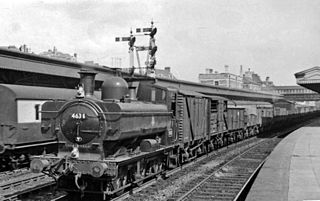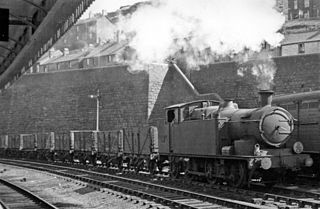
The first Locomotives of the Great Western Railway (GWR) were specified by Isambard Kingdom Brunel, but Daniel Gooch was soon appointed as the railway's Locomotive Superintendent. He designed several different 7 ft 1⁄4 in broad gauge types for the growing railway, such as the Firefly and later Iron Duke Class. In 1864 Gooch was succeeded by Joseph Armstrong who brought his standard gauge experience to the workshops at Swindon. To replace some of the earlier locomotives, he put broad gauge wheels on his standard gauge locomotives and from this time on all locomotives were given numbers, including the broad gauge ones that had previously carried just names.

The GWR 5700 Class is a class of 0-6-0PT steam locomotive built by the Great Western Railway (GWR) and British Railways (BR) between 1929 and 1950. With 863 built, they were the most prolific class of the GWR, and one of the most numerous classes of British steam locomotive.

The 1361 Class were small 0-6-0ST steam locomotives built by the Great Western Railway at their Swindon Works, England, mainly for shunting in docks and other sidings where track curvature was too tight for large locomotives.

The Great Western Railway (GWR) 1366 Class is a class of 0-6-0 pannier tank steam locomotives built in 1934. They were a useful design and because of their light weight and short wheelbase and were often used on dockside branches or other lines with sharp curvatures.

The GWR 5600 Class is a class of 0-6-2T steam locomotive built between 1924 and 1928. They were designed by Charles Collett for the Great Western Railway (GWR), and were introduced into traffic in 1924. After the 1923 grouping, Swindon inherited a large and variable collection of locomotives from historic Welsh railway companies, which did not fit into their standardisation programme. GWR boiler inspectors arrived en masse and either condemned the original locomotives or had them rebuilt. The systematic destruction of many examples of locomotives, most still in serviceable condition, followed, but various were worked alongside 5600 Class.

The Great Western Railway (GWR) 4500 Class or Small Prairie is a class of 2-6-2T steam locomotives.

The Great Central Railway (GCR) Class 9F was a class of 0-6-2T steam locomotive built between 1891 and 1901. From 1923 the locomotives were redesignated Class N5.

British Rail Class D3/10 was a single experimental diesel-electric shunter locomotive commissioned by the Great Western Railway (GWR) in England, and later taken over by British Railways.

Birkenhead Mollington Street was a former traction maintenance depot located at Mollington Street in Birkenhead, England, on the Birkenhead Dock Branch railway. Although never directly connected by rail, the depot was situated less than 200 m (660 ft) from Birkenhead Central railway station. The depot serviced steam and subsequently diesel locomotives until 1985, when it was closed and demolished. As of 2018, the site of the depot is still disused.

The Rhymney Railway M class was a class of 0-6-2T tank locomotive introduced into traffic on the Rhymney Railway in 1904. These were substantial sized tank engines, and weighed 66 long tons and were 36 feet 9 inches (11.20 m) in length.
The Rhymney R class was a class of 0-6-2T steam locomotive introduced into traffic in 1907 designed by the railway's engineer Hurry Riches. These were substantial sized tank locomotives, and weighed 67 long tons and were 37 feet (11.28 m) in length.

The Rhymney Railway A class were 0-6-2T tank locomotives introduced into traffic in 1910 and designed by the railway's engineer Hurry Riches. These were substantial sized tank engines, and weighed 64 long tons and were 35 ft 9 in (10.90 m) in length.
The Rhymney Railway P class was a class of 0-6-2T steam locomotive introduced into traffic in 1909 designed by the Rhymney Railway's engineer C. T. Hurry Riches. These were substantial sized tank locomotives, weighed 60 long tons and were 35 feet 0 inches (10.67 m) in length.

The GWR 0-4-0ST steam locomotives were acquired by the Great Western Railway at the 1923 grouping. They came from small railways and from contractors. Some of them survived into British Railways ownership in 1948 and a few are preserved.

The LNWR 317 class, consisted of a class of 20 square saddle-tanked steam locomotives built by the London and North Western Railway at their Crewe Works between 1896 and 1901. They had a very short coupled wheelbase, with a trailing Bissel truck to carry weight.
The Barry Railway Class H was a small class of seven 0-8-2T tank locomotives built for the Barry Railway by Sharp Stewart in 1896. When they were introduced they were the first locomotives in Britain to use the 0-8-2 wheel arrangement.

The Taff Vale Railway O2 class was a class of 0-6-2T steam tank locomotives designed by Tom Hurry Riches and introduced to the Taff Vale Railway in 1899.

The L&YR Class 24 was a class of short-wheelbase 0-6-0T steam locomotives of the Lancashire and Yorkshire Railway (L&YR). It was designed by Aspinall and introduced in 1897 for shunting duties. Twenty locomotives were built, but six were withdrawn between 1917 and 1922.

The G&SWR 5 Class are 0-6-0T steam locomotives designed by Peter Drummond for the Glasgow and South Western Railway (G&SWR) and introduced in 1917. The class was originally designated 5 Class but, after the G&SWR's 1919 renumbering, this was changed to 322 Class. After passing to the London, Midland and Scottish Railway (LMS) in 1923 they were given power classification 2F.
















